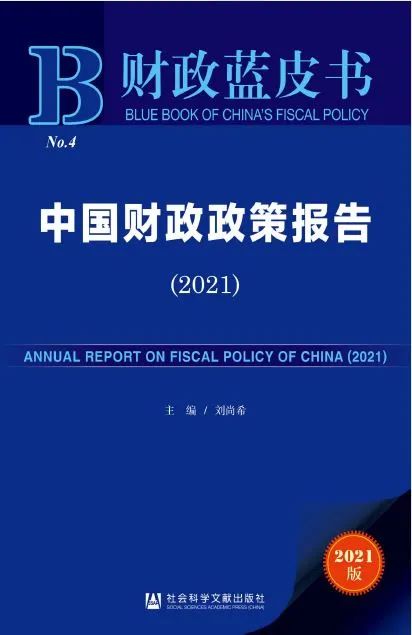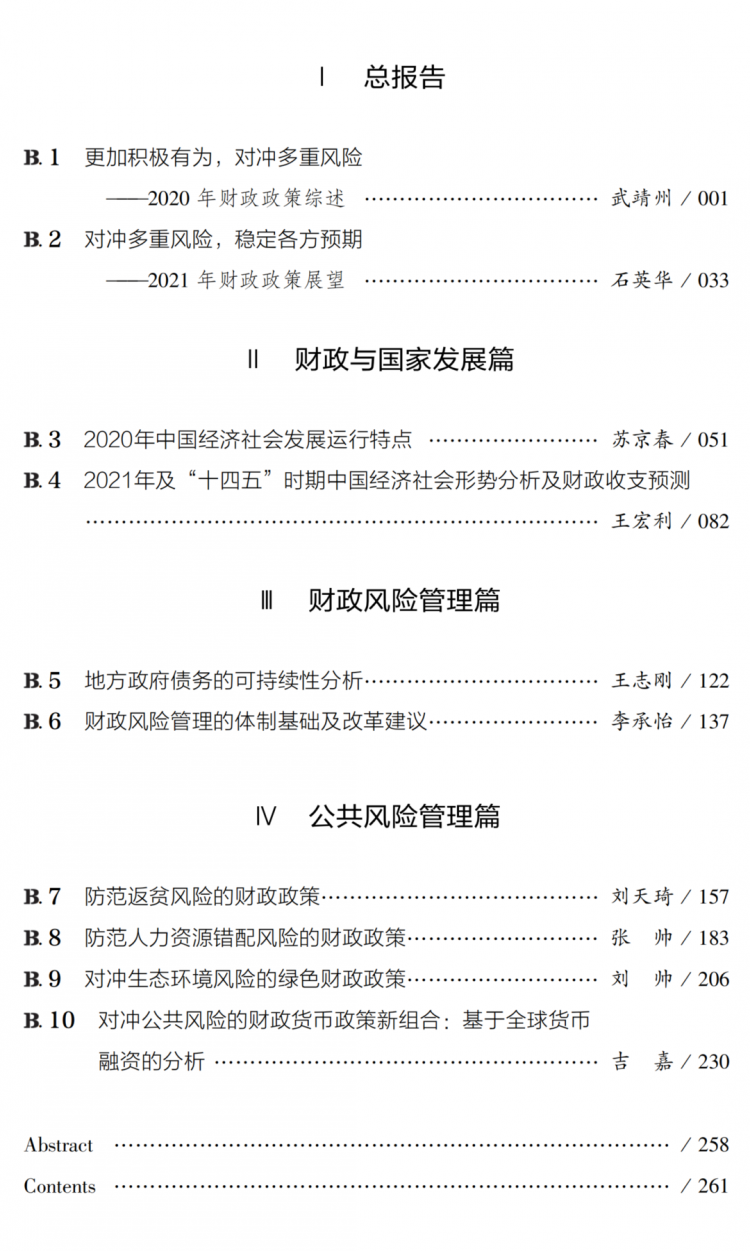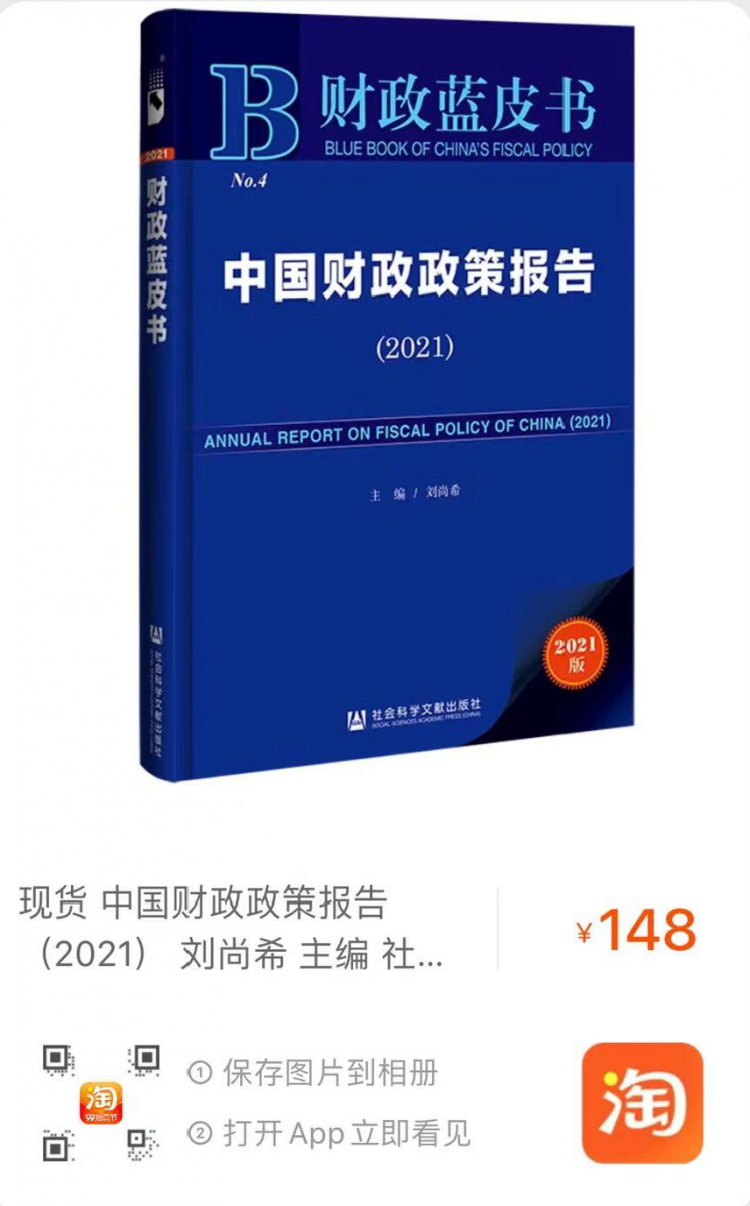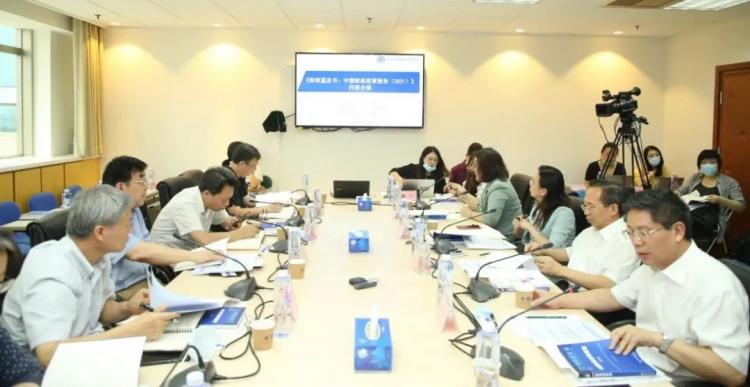【CAFS新书推荐】《财政蓝皮书:中国财政政策报告(2021)》

▲
CAFS新书推荐
《财政蓝皮书:中国财政政策报告(2021)》
NEWEST TRENDS 2

BLUE BOOK OF CHINA'S FISCAL POLICY
ANNUAL REPORT ON FISCAL POLICY OF CHINA (2021)
Basic Information
基本信息主编:刘尚希
出版社:社会科学文献出版社
——
Abstract
内容摘要在新冠肺炎疫情的冲击下,2020年世界经济严重衰退,大国博弈仍未减弱。疫情风险、经济运行风险、公共风险多重叠加并相互转化,中国经济社会运行承受了前所未有的压力。对冲风险成为2020年财政政策的主基调,稳定经济基本盘成为财政政策的重要目标。但以扩大公共债务对冲公共风险,也使得财政风险进一步积累。从中长期看,应注意财政政策空间逐步收窄的趋势,更关注财政收支和政府债务的稳健平衡,增强财政政策的可持续性。
新阶段、新理念、新格局下财政政策的目标和逻辑路径发生变化,中长期视野下财政政策应聚焦“人”的现代化发力。2021年是“十四五”规划的开局之年,也是“两个百年”奋斗目标交汇与转换之年,财政政策要聚焦稳定各方预期。在经济层面,财政政策可着力对冲疫情衍生风险、宏观经济运行风险等多重风险,稳定市场主体预期;在社会层面,财政政策可着力对冲人力资本配置风险、利益分配失衡风险和环境可持续风险,稳定各类主体预期。同时,还需要通过完善预算管理和深化财政体制改革,优化和拓展财政政策空间,稳定各级政府主体的预期。
经济形势预测结果显示,在疫情得到持续有效控制的条件下,2021年全国GDP增速在6.5%~8%,CPI增速将低于2020年水平,PPI在经济恢复的带动下上行;如果出现疫情反弹的情景,GDP增速可能维持2.3%或略高。从中长期看,“十四五”期间经济增速在5%以上。财政收支预测结果显示,2021年一般公共预算收入显著提升,“十四五”期间增速放缓;同年财政支出仍保持较高增速,整个“十四五”期间财政支出依旧面临较大压力。不过,随着医疗、社会保障、科学技术等领域的财政投入实现较快增长,财政支出结构有望优化,资金使用效率有望提升。
在财政风险管理方面,中国地方政府债务问题在新冠肺炎疫情冲击下更加凸显,从时间和空间两个维度看待债务价值,建议把债务风险和公共风险的平衡作为地方政府债务可持续性的基本标准。总体上财政改革的每一步都带有公共风险变化的烙印,应从财政风险管理的角度审视当前财政体制的问题,以防范化解公共风险为导向,展望下一步财政体制改革。
本报告最后围绕社会广泛关切的政策领域开展探讨。在反贫困治理中,财政政策起到了举足轻重的作用,今后的工作重点在于防范返贫风险、巩固脱贫成果。“十四五”时期,为防范由新型就业发展、经济增速放缓、老龄化进程加快和城镇化推进等因素引发人力资源错配的风险,财政政策要以“人”为核心、促进人全面发展和基本公共服务均等化,提高就业稳定性、充分性和平等性。在资源环境领域,应完善环境风险共担机制、加强防范跨区域跨流域环境风险,建立全生命周期绿色低碳激励机制。
为防止新冠肺炎疫情冲击引发深度经济衰退,发达国家普遍采取超常规的财政、货币政策手段,并在政策空间的制约下加强财政部门与货币当局的协同合作。未来错综复杂的国际局势恐将加剧风险的全球性外溢影响,原有的宏观调控思路难以解决经济结构性变化衍生的潜在风险。中国要把握当前的战略机遇,在风险理性的基础上研究货币融资策略的适度性与制度化管理,优化利用公共资源对冲公共风险的效率,构建发展的确定性。
关键词:财政政策 公共风险 经济形势 财政风险
The COVID-19 pandemic shock has gravely wounded the world economy in the year of 2020,however,brings no relief to international tensions among major countries. The risks to the pandemic,economic development and public risk are increasingly interrelated,as China’s social economic outlook comes under unprecedented level of pressure. Risk hedging becomes the theme of fiscal policy in 2020,and economic fundamentals stabilizing becomes the major target. In the medium to long-term,the policy space of the fiscal authority is set to narrow down,particular attention should be paid to the robustness of fiscal balance and government debt,alongside other issues derived from public finance sustainability.
The goals and logical reasoning of fiscal policy are evolving under the new development stage,philosophy,and paradigm. In the medium to long-term,fiscal policy should focus on human capital modernization. The year 2021 will mark the launch of the 14th Five-Year Plan,it is also the period in which the timeframes of the two centenary goals converge,fiscal policy needs to stabilize all stakeholders’ expectations. From the economic perspective,fiscal policy should guide market expectation by hedging pandemic-induced risks,macroeconomic development risk etc. From the social perspective,fiscal authority can stabilize various stakeholders’ expectations via risk hedging related to human capital misallocation,profit sharing imbalance and environmental sustainability. Meanwhile,budget management and fiscal institutional reforms need to be push forward,optimizing and expanding policy space,as well as stabilizing the expectations from all levels of the state authority.
Economic outlook forecasts show that,assuming the pandemic shock remains under effective control,national GDP growth rate in 2021 lies within 6.5%-8%. While CPI growth shall be lower than last year,PPI is set to rebound driving by the economic recovery. Under the assumption of pandemic resurgence,however,GDP growth may stay at 2.3% or above. In the medium to long-term,annual growth shall reach at least 5% during the 14th Five-Year Plan. Based on the forecast results from fiscal balance,revenues in the general public budget is set to increase significantly in 2021,and the growth rate is trending downward covering the 14th Five-Year Plan;fiscal spending might also expand greatly,although is expected to stay at the higher level throughout the 14th Five-Year Plan period. Nevertheless,spending structure and funding efficiency might be improving,as greater public spending will be devoted to medical facility,social security,and technology.
On the fiscal risk front,the debt issue of subnational governments in China is highlighted by the COVID-19 shock. Considering the dimensions of time and space,the balancing of debt risk and public risk should be the benchmark to evaluate subnational debt management. Overall,every milestone along the historical fiscal reform progress can be marked accordingly by public risk dynamics. This means fiscal institutional issues should come under scrutiny from the perspective of fiscal risk management,and the outlook of fiscal institutional reform is projected by public risk orientation.
This report further investigates some policy topics which are receiving increasing public attention. In the effort to alleviate poverty,fiscal policy plays a dominant role. In the future,it is critical to prevent those who have recently lifted,from returning to poverty. In the era of the 14th Five-Year Plan,it is important to overcome the misallocation risks stemming from creative employment,slowing economic growth,aging society,urbanization etc. Fiscal policy must focus on human capital development and equal public service,improving the resilience,comprehensiveness,and fairness of employment opportunities. In the environmental area,more efforts should be spent on institutional design,such as the environment risk sharing mechanism,an interregional environmental risk management tool,and the life-cycle lower carbon incentive system.
To counter the severe impact from the COVID-19 pandemic shock,developed countries broadly adopted unconventional macroeconomic policy,and strengthened fiscal-monetary policy coordination within limited policy space. geopolitical tensions could induce greater international risk spillover,yet the novel challenges generated by economic structural change can hardly be addressed by traditional macroeconomic theory. Thus,the effects and transmission mechanism of monetary finance should be thoroughly studied. China Should grasp the current strategic opportunity,by controlling the uncertainty along the path of national development,public resource can be devoted to hedge public risk more efficiently.
Keywords:Fiscal Policy;Public Risk;Macroeconomic Outlook;Fiscal Risk
扫描或长按识别下方二维码,查阅更多本书精彩内容(中英双语)

——
Contents
目录

①保存下方图片到相册
②打开手机淘宝App即可购买图书


审稿:程瑜闫晓茗
编辑:李雅煊
▼
往期精彩回顾
▼
“成本高企与风险对冲”经济形势研讨会暨《财政蓝皮书:中国财政政策报告(2021)》发布会在京举行
【CAFS新书推荐】《解析经济V型复苏—中国经济运行分析与形势展望报告2021》

(本文转载自 ,如有侵权请电话联系13810995524)
* 文章为作者独立观点,不代表MBAChina立场。采编部邮箱:news@mbachina.com,欢迎交流与合作。
热门推荐
备考交流
最新动态
- 24招生 | 中国财政科学研究院2024年招收攻读硕士学位研究生章程 2023-12-21
- 【CAFS两会热评】张行 | 财政支持乡村振兴的几个发力点 2023-03-14
- 【CAFS两会热评】封北麟 | 警惕全球金融脆弱性上升,有效防范化解重大风险 2023-03-11
活动日历
- 01月
- 02月
- 03月
- 04月
- 05月
- 06月
- 07月
- 08月
- 09月
- 10月
- 11月
- 12月
- 05/04 报名 | “中国经济变局下的企业风险管理”复旦大学李若山教授公开课暨联合宣讲会
- 05/08 集赞赢取精美礼品 | 面试诀窍、备考经历、海外交换,报名5月8日面试圆桌派,用10个问题揭秘三位高分学长的备考秘籍!
- 05/11 报名 | “企业数据资产盈利的商业模式”复旦大学教授公开课暨项目招生说明会
- 05/12 招生工作|浙工大校园开放日暨MBA、MEM项目宣讲会通知
- 05/12 「复旦大学 EMBA 项目」与「复旦-台大 EMBA 项目」介绍会 | 活动预告
- 05/12 香港大学MBA大师级示范课 | 双剑合璧,对话未来,一起再飞跃!
- 05/17 限时抢位!长江商学院MBA项目5月北京体验课
- 05/18 西交利物浦大学IMBA公开课 | 颠覆性的市场环境将为领导力带来哪些挑战?
- 05/18 5/18校园开放日,邂逅最美财大!2024上财商学院首场MBA/EMBA Pre-Sufer Campus Open Day
- 05/18 5月18日 | 全国首场中国商学院招生巡展暨2025招生政策发布会(北京站)重磅来袭!
热门资讯
MBA院校号
-
最新动态:
【推荐】《视野·管理通鉴》2024(二)
















